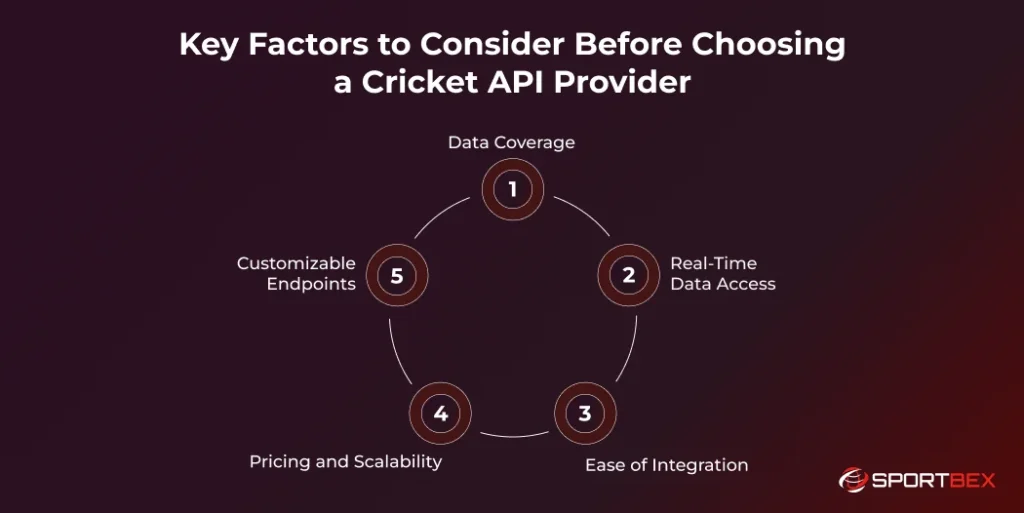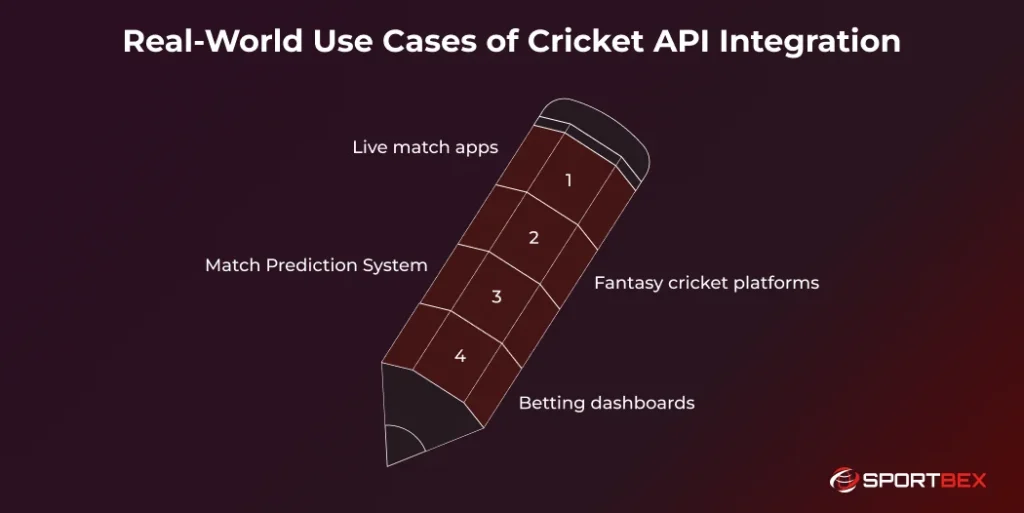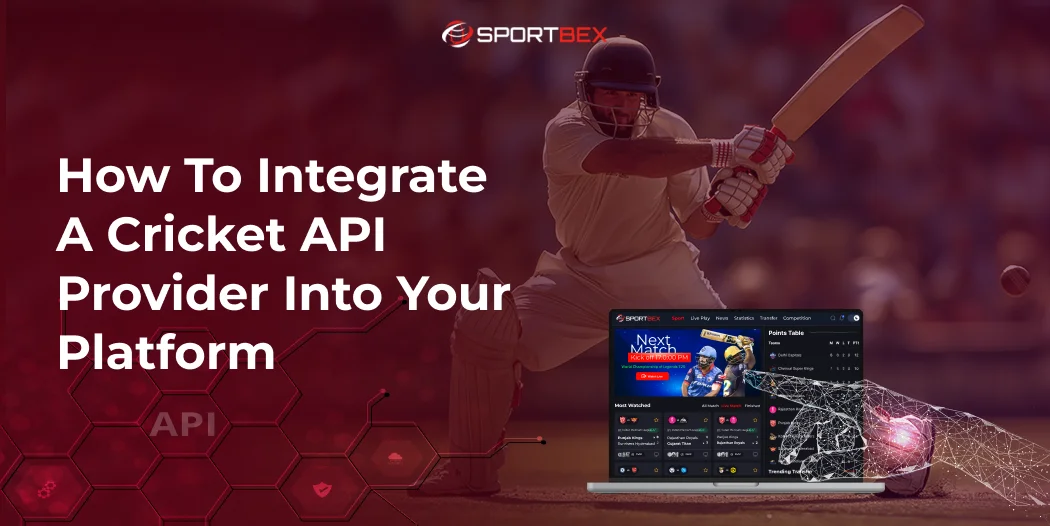If you want to build a platform that delivers real-time cricket scores, match updates, and player stats, integrating a reliable Cricket API is essential. Cricket APIs give instant access to live scores, team rankings, player performance data, and historical records, making them a must-have for modern cricket apps.
Whether it’s a live match app, fantasy cricket platform, or betting dashboard, a Cricket API can enhance user experience, deliver real-time data, and help your platform scale efficiently.
Selecting a Cricket API provider requires careful consideration. Focus on data accuracy, real-time updates, and ease of integration. When learning how to integrate a Cricket API provider into your platform, also evaluate pricing plans, customer support, and compatibility with your existing technology to ensure a seamless setup.
By following best practices, you’ll be able to select a provider that meets your platform’s needs, integrate their services step-by-step, and unlock real-world use cases that engage cricket fans like never before.
What Is a Cricket API?
A Cricket API is a service that provides seamless access to comprehensive cricket data for apps, websites, or dashboards. These APIs deliver real-time match scores, player statistics, team rankings, historical data, and upcoming fixtures, enabling platforms to provide accurate and engaging cricket experiences.
By integrating a Cricket API, platforms can automatically fetch live updates, eliminating the need for manual data collection and ensuring fans always have the latest information at their fingertips.
Cricket APIs are essential for live score apps, fantasy cricket platforms, sports news websites, and cricket betting dashboards, offering features such as ball-by-ball updates, performance analytics, and detailed player metrics.
Key Factors to Consider Before Choosing a Cricket API Provider

1. Comprehensive Data Coverage
A top Cricket API provider offers extensive data coverage, including international matches, major domestic leagues like IPL, BBL, and PSL, and even smaller regional tournaments. With detailed player statistics, live scores, historical data, and performance metrics, these APIs provide everything needed to create engaging cricket platforms for fans.
Comprehensive cricket data covers international and domestic leagues, offering live scores, player stats, historical insights, and even live sports streaming, ensuring the ultimate fan engagement experience.
2. Real-Time Data Access
Cricket fans expect instant updates. Choosing a provider that delivers real-time scores and match events with minimal latency ensures users stay engaged and informed. This is particularly critical for live score apps and sports betting platforms, where even slight delays can impact decisions and user experience.
Get real-time cricket scores and updates with minimal delay, keeping fans engaged and informed for live apps and betting platforms. Instant, accurate data access.
3. Ease of Integration
The best Cricket APIs come with comprehensive documentation, sample code, and responsive support, making integration straightforward. Smooth Cricket API integration helps reduce errors, save time, and ensures your platform functions efficiently while delivering seamless, real-time cricket data to users.
Top Cricket APIs offer clear documentation, sample code, and support, making integration easy, reducing errors, and delivering seamless real-time cricket data.
4. Pricing and Scalability
Select a provider with flexible pricing plans that align with your budget and provide value without hidden costs. Additionally, the API should scale effectively as your platform grows, maintaining performance and reliability even with an increasing number of users or live match events.
Pick a Cricket API that offers budget-friendly pricing and scalable performance, ensuring consistent real-time data delivery as your app grows.
5. Customizable Endpoints
Modern apps benefit from APIs that allow customized data requests, fetching only the information required. This reduces unnecessary server load, improves app performance, and ensures faster load times and a smoother user experience, making your platform more responsive and efficient.
Cricket APIs with customizable endpoints fetch only needed data, reducing server load, improving performance, and ensuring fast, smooth user experiences.
Real-World Use Cases of Cricket API Integration

1. Live Match Apps
Create immersive live cricket match apps that deliver ball-by-ball updates, player statistics, and live commentary. With accurate and real-time data from cricket APIs, fans can stay connected to every match, no matter where they are.
These apps provide an engaging experience that goes far beyond just the score by offering insights, trends, and player performance in real time.
2. Fantasy Cricket Platforms
APIs power fantasy sports apps by providing live player data, historical stats, and automatic scoring updates. They help deliver real-time insights and enhance overall user engagement.
By integrating a reliable fantasy cricket API provider, platforms can engage users with features like real-time score syncing, performance metrics, team analytics, and game predictions, enhancing user engagement and overall gameplay experience.
3. Sports News Portals
Cricket APIs serve as the foundation for sports news portals, delivering detailed match previews, real-time scores, post-match analysis, and player performance.
They ensure every piece of content remains accurate, up to date, and dynamic, helping publishers offer fans a one-stop destination for cricket insights, results, and news coverage.
4. Betting Dashboards
For cricket betting dashboards, a reliable Cricket Betting API provider is essential for fetching live match data, player stats, odds, and performance trends directly from trusted sources.
This real-time integration allows users to make quick, informed betting decisions supported by accurate and dynamic updates, enhancing trust, speed, and engagement within the betting ecosystem.
Get Live Cricket Data Now
Integrate Sportbex Cricket API for real‑time scores, stats & odds.
Step-by-Step Guide to Integrating a Cricket API Into Your Platform
Step 1: Choose Your Cricket API Provider
Begin by evaluating the top cricket API providers based on key factors such as reliability, ease of integration, scalability, and data accuracy. Compare their features, pricing, and user reviews to find the best fit for your business.
Whether you’re building a fantasy cricket platform, a live score app, or a data analytics solution, selecting the right API can significantly boost platform performance.
Step 2: Sign Up and Get Your API Key
Create an account on your selected provider’s platform and complete the registration or verification steps. Review their subscription plans and choose one that best suits your project’s needs, whether you prioritize advanced features, scalability, or budget.
After registration, you’ll receive a unique API key, which serves as your authentication token. This key allows your system to securely connect with the API and start retrieving real-time cricket data.
Step 3: Review API Documentation
Carefully read through the API documentation to understand how the cricket API works. Familiarize yourself with endpoints, authentication processes, request formats, and response structures.
Pay attention to rate limits, error handling, and advanced options like data filtering or extended statistics.
Step 4: Set Up Authentication
Authenticate your integration by including the API key in your requests. This step validates your access and ensures that your data queries function correctly.
Keep your API key secure by storing it in safe server environments or encrypted files. Avoid exposing it in public repositories or unsecured locations.
Step 5: Fetch and Display Cricket Data
Start making requests to fetch live cricket scores, player stats, and tournament schedules. This data can enhance fan engagement and interactivity on your platform.
You can integrate live score widgets, player profiles, performance charts, and team analytics to offer users a rich and dynamic cricket experience.
Step 6: Handle Errors and Refresh Data Regularly
Develop strong error-handling mechanisms to manage API request failures gracefully. Display user-friendly messages if issues occur and set up automatic retry systems for temporary connection problems.
Implement periodic refresh intervals to ensure the displayed data stays accurate and up to date. Keeping data fresh helps your cricket platform maintain user trust and reliability.
Step 7: Test and Deploy Your Integration
Thoroughly test your cricket API integration before launching. Use live matches to examine data accuracy, update speed, and overall system performance in real-world scenarios.
Verify that your platform responds quickly, delivers consistent information, and provides a seamless experience across devices and user segments.
What are some options available for Cricket API providers?
Many Cricket API providers give real-time scores, player stats, and match updates, but choosing the best Cricket API provider ensures accurate data, comprehensive coverage of international and domestic matches, team rankings, player performance, and historical results.
Using reliable Cricket API providers helps your app or website display accurate, real-time cricket data, keeping fans engaged. They are perfect for live score updates, fantasy cricket apps, and betting dashboards, providing users with a smooth and interactive cricket experience.
Conclusion
Integrating a Cricket API provider into your platform has become essential for engaging modern cricket fans and fantasy sports enthusiasts.
Whether you’re developing a live score app, a fantasy cricket platform, or a sports analytics dashboard, leveraging a reliable Fantasy Sports API ensures access to accurate, real-time match data, player statistics, and fixtures that audiences expect.
Choosing the right Cricket API and integrating it seamlessly can transform your platform’s performance. For Cricket Betting Sites, it enables fast updates, detailed match insights, and an immersive user experience, keeping fans informed and engaged throughout every game.
A well-implemented Cricket API not only boosts user engagement and platform credibility but also provides a competitive edge in the rapidly expanding sports and fantasy gaming industry.
Take Your Cricket Platform Live Now
Tap into real-time updates & live data with minimal latency.
Frequently Asked Questions
A Cricket API provides real-time access to cricket data, including live scores, player stats, team rankings, and historical match information, which can be integrated into apps and websites.
When selecting a Cricket API provider, consider data coverage, real-time updates, ease of integration, pricing, scalability, and customizable endpoints to ensure reliable and accurate performance.
Most Cricket APIs offer detailed documentation, sample code, and support, making it simple to fetch live scores, player stats, and match updates for apps, fantasy platforms, or betting dashboards.
Cricket APIs are used in live match apps, fantasy cricket platforms, match prediction systems, and betting dashboards, helping platforms deliver engaging and real-time cricket content.
Yes, some Cricket API providers offer limited-access plans for testing or small-scale applications, while premium plans provide full access to live scores, player stats, and historical data.
Recent Blog
What Makes the Cricket Exchange API Valuable for Operators?
November 19, 2025
 9 min
9 min
The Role of Real-Time Data APIs in Horse Racing Prediction
November 19, 2025
 9 min
9 min







